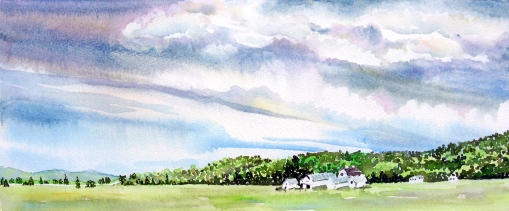I have been working with different ink and watercolor techniques. I began the above painting with a line drawing of the tiger. The next thing I did was ink in about four of his stripes with a small watercolor brush and india ink (waterproof). Before each stripe dried, I spritzed it with water. The ink fans out in a fuzzy pattern to either side of the stripe. At first it looks like I am ruining my image, but as the ink dries, the color becomes lighter. I would dry that area with a hair dryer and move on to the next group of stripes and repeat the spritzing and the hair drying until I had the stripes done. I waited for this first step to dry and then repainted all the stripes so that the center of each one was as black as I could get it. I worked black india ink into the shadows around the tiger, wet-in-wet, just like I use wet-in-wet with my watercolors. After this stage dried, I painted with watercolor. If you click on the above image and click on it a second time, it will enlarge enough so you can move around it and actually see the textures the spritzed ink created on the surface of the watercolor paper.
I have done this type of ink and watercolor before. You can view one I did with a nib here. I also have worked with an eye dropper here and here. This technique is defintiely not for the artist that wishes to control every element of his/her painting. I find myself having to let go a little of my control and work with what we watercolorists call “Happy Accidents”. The reference image is just that, a reference image, because I usually have to stray from it in order to finish these.













